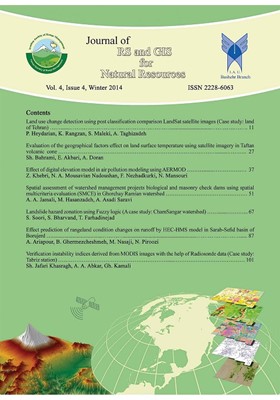-
-
List of Articles
-
Open Access Article
1 - Land use change detection using post classification comparison LandSat satellite images (Case study: land of Tehran)
Peyman Heydarian Kazem Rangzan Saeid Maleki Ayoub Taghizadeh -
Open Access Article
2 - Evaluation of the geographical factors effect on land surface temperature using satellite imagery in Taftan volcanic cone
Shahram Bahrami Elahe Akbari Atefeh Doran -
Open Access Article
3 - Effect of digital elevation model in air pollution modeling using AERMOD
Zahra Khebri Narjes-Sadat Mousavian Nadoushan Farhad Nezhadkurki Nabiollah Mansouri -
Open Access Article
4 - Spatial assessment of watershed management projects biological and masonry check dams using spatial multicriteria evaluation (SMCE) in Ghorchay Ramian watershed
Ali Akbar Jamali Mohammad Hasanzadeh Angizeh Asadi Saravi -
Open Access Article
5 - Landslide hazard zonation using Fuzzy logic (A case study: ChamSangar watershed)
Salman Soori Siamak Bharvand Taher Farhadinejad -
Open Access Article
6 - Effect prediction of rangeland condition changes on runoff by HEC-HMS model in Sarab-Sefid basin of Borujerd
Ali Ariapour Bagher Ghermezcheshmeh Mojtaba Nasaji Naghmeh Piroozi -
Open Access Article
7 - Verification instability indices derived from MODIS images with the help of Radiosonde data (Case study: Tabriz station)
Shabnam Jafari Khasragh Ali Akbar Abkar Gholam Ali Kamali
-
The rights to this website are owned by the Raimag Press Management System.
Copyright © 2021-2025







